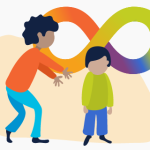What Is Autism Spectrum Disorder?
 Autism is a group of developmental brain disorders, collectively called autism spectrum disorder (ASD). The term “spectrum” refers to the wide range of symptoms, skills, and levels of impairment, or disability, that children with ASD can have. Some children are mildly impaired by their symptoms, but others are severely disabled.
Autism is a group of developmental brain disorders, collectively called autism spectrum disorder (ASD). The term “spectrum” refers to the wide range of symptoms, skills, and levels of impairment, or disability, that children with ASD can have. Some children are mildly impaired by their symptoms, but others are severely disabled.
ASD is diagnosed according to guidelines listed in the Diagnostic and Statistical Manual of Mental Disorders, Fifth Edition. Before 2013, autism disorders were identified by types: autistic disorder, Asperger’s Syndrome and Pervasive Developmental Disorder – Not Otherwise Specified (PDD-NOS). Under the new criteria, autism, Asperger’s Syndrome, and PDD-NOS have been collapsed into a single diagnosis: autism spectrum disorder.
Signs and Symptoms
ASDs begin before the age of 3 and last throughout a person’s life, although symptoms may improve over time. Some children with an ASD show hints of future problems within the first few months of life. In others, symptoms might not show up until 24 months or later. Some children with an ASD seem to develop normally until around 18 to 24 months of age and then they stop gaining new skills, or they lose the skills they once had.
The list below gives some examples of common types of behaviors in people diagnosed with ASD. Not all people with ASD will have all behaviors, but most will have several of the behaviors listed below.
Social communication / interaction behaviors
- Making little or inconsistent eye contact
- Appearing not to look at or listen to people who are talking
- Infrequently sharing interest, emotion, or enjoyment of objects or activities (including infrequent pointing at or showing things to others)
- Not responding or being slow to respond to one’s name or to other verbal bids for attention
- Having difficulties with the back and forth of conversation
- Often talking at length about a favorite subject without noticing that others are not interested or without giving others a chance to respond
- Displaying facial expressions, movements, and gestures that do not match what is being said
- Having an unusual tone of voice that may sound sing-song or flat and robot-like
- Having trouble understanding another person’s point of view or being unable to predict or understand other people’s actions
- Difficulties adjusting behaviors to social situations
- Difficulties sharing in imaginative play or in making friends
Restrictive / repetitive behaviors
- Repeating certain behaviors or having unusual behaviors, such as repeating words or phrases (a behavior called echolalia)
- Having a lasting intense interest in specific topics, such as numbers, details, or facts
- Showing overly focused interests, such as with moving objects or parts of objects
- Becoming upset by slight changes in a routine and having difficulty with transitions
- Being more sensitive or less sensitive than other people to sensory input, such as light, sound, clothing, or temperature
Current estimates are that 1 in 36 children have an autism spectrum disorder. Many parents report that their child with an autism spectrum disorder was exhibiting difficulties prior to the age of two, but was not diagnosed until two to three years after concerning behaviors emerged.





